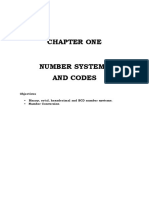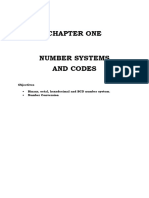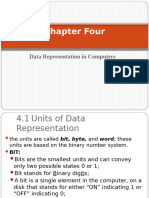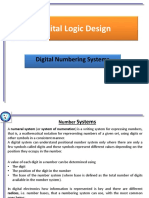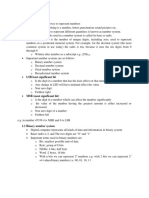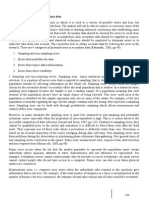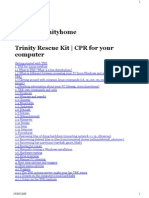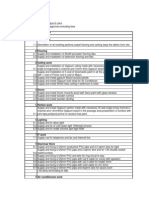Chapter One: Objectives Binary, Octal, Hexadecimal and BCD Number System. Number Conversion
Chapter One: Objectives Binary, Octal, Hexadecimal and BCD Number System. Number Conversion
Uploaded by
Wazazzu WazazzuCopyright:
Available Formats
Chapter One: Objectives Binary, Octal, Hexadecimal and BCD Number System. Number Conversion
Chapter One: Objectives Binary, Octal, Hexadecimal and BCD Number System. Number Conversion
Uploaded by
Wazazzu WazazzuOriginal Description:
Original Title
Copyright
Available Formats
Share this document
Did you find this document useful?
Is this content inappropriate?
Copyright:
Available Formats
Chapter One: Objectives Binary, Octal, Hexadecimal and BCD Number System. Number Conversion
Chapter One: Objectives Binary, Octal, Hexadecimal and BCD Number System. Number Conversion
Uploaded by
Wazazzu WazazzuCopyright:
Available Formats
CHAPTER ONE
NUMBER SYSTEMS AND CODES
Objectives Binary, octal, hexadecimal and BCD number system. Number Conversion
Number Systems and Codes
1.1
Binary Numbers
system is used to represent the voltage levels of a two voltage levels present in a digital circuit, logic The high voltage is +5V and the low voltage is +0V. represent the logic low as a 0 and the logic high as a
Output dalam desimal proses dalam binari Input dalam desimal
The binary number digital circuit. Only High and logic Low. The binary numbers 1.
A calculator is an example of a digital system. Decimal numbers are pressed on the keypad, where the input values are converted to binary for processing, then converts the answers to a decimal value before displaying them. Number conversion occurs extensively in a digital circuit. In this chapter, you will learn numbers systems and codes used in digital circuit. You will also learn how to perform conversion from one number system to another. A decimal number can be converted to a binary number by successively dividing the number by 2 as follows: 87 2 = 43 43 2 = 21 21 2 = 10 10 2 = 5 52=2 22=1 1 2= 0 remainder remainder remainder remainder remainder remainder remainder 1 1 1 0 1 0 1 LSB (right-most bit)
MSB (left-most bit)
Therefore 8710 = 10101112 Note that the first remainder becomes the most significant bit (MSB). The last remainder becomes the least significant bit (LSB). A binary number is converted to a decimal number by summing together the weights of various positions in the binary number which contain a 1. For example, 10101112 = 8710.
Number Systems and Codes MSB 26 1 = = = 25 0 24 1 24 16 23 0 + + 22 1 21 1 LSB 20 1 Bit Weights binary number
+ 26 64 + 8710.
22 + 21 + 20 4 + 2 + 1
1.2 Octal Number
A decimal number can be converted to an octal number by successively dividing the number by 8 as follows: 266 8 = 33 33 8 = 4 48=0 remainder 2 remainder 1 remainder 4 LSD (right-most digit) MSB (left-most digit).
Therefore 26610 = 2148 To convert an octal number to a decimal number, multiply each octal value by the weight of the digit and sum the results. For example, 4128 = 26610. MSD 82 4 = = = (4 x 82 ) + 256 + 26610. LSD 80 Octal Digit Weights 2 Octal Number
81 1 (1 x 81) + 8 +
(2 x 80) 2
Number Systems and Codes
Each octal digit can be represented by a 3-bit binary number as shown below: Octal Digits 0 1 2 3 4 5 6 7 3-bit Binary number 000 001 010 011 100 101 110 111
Conversion from octal to binary is very straightforward. Each octal digit is replaced by 3-bit binary number. For example, 4728 = 100 111 0102. 4 100 7 111 2 001 Octal number Binary number
A binary number is converted into an octal number by taking groups of 3 bits, starting from LSB, and replacing them with an octal digit. For example, 110101102 = 3268. 011 3 010 2 110 6 Binary number Octal number
1.3 Hexadecimal Number
The hexadecimal number uses base 16. It uses the digits 0 through 9 plus the letters A, B, C, D, E and F. The letter A stands for decimal 10, B for 11, C for 12, D for 13, E for 14 and F for 15. Hexadecimal 0 1 2 3 4 Decimal 0 1 2 3 4 Binary 0000 0001 0010 0011 0100
Number Systems and Codes 5 6 7 8 9 A B C D E F 5 6 7 8 9 10 11 12 13 14 15 0101 0110 0111 1000 1001 1010 1011 1100 1101 1110 1111
A decimal number can be converted to hex number by successively dividing the number by 16 as follows: 423 16 = 26 26 16 = 1 1 16 = 0 remainder 7 remainder 10 remainder 1 LSB A MSB
Therefore 42310 = 1A716 To convert a hex number to a decimal number, multiply each hex value by the weight of the digit and sum the results. For example, 1A716 = 42310. MSD 82 1 = = = LSD 80 Hex Digit Weights 7 Hex Number
81 A
(1 x 162 ) + (10 x 81) + 256 + 160 + 42310.
(7 x 80) 7
Each hex digit can be represented by a 4-bit binary number as shown above. Conversion from hex to binary is very straightforward. Each hex digit is replaced by 4-bit binary number.
6 For example, 1A716 1 1
=
Number Systems and Codes 1 1010 01112. 7 0111
A 1010
A binary number is converted into an octal number by taking groups of 4 bits, starting from LSB, and replacing them with a hex digit. For example, 110101102 = 3268. For example, 101111110101102 = 2FD616. 10 2 1111 F 1101 D 0110 6
1.4 BCD Code
Conversions between decimal and binary can become long and complicated for large numbers. For example, convert 87410 to binary. The answer is 11011010102, but it takes quite a lot of time and effort to make this conversion. We call this straight binary coding. The Binary-Coded-Decimal (BCD) code makes conversion much easier. Each decimal digit, 0 through 9, is represented with a 4-Bit BCD code as shown below. The BCD code 1010, 1011, 1100, 1101, 1110 and 1111 are not used. Decimal Digit 0 1 2 3 4 5 6 7 8 9 BCD Code 0000 0001 0010 0011 0100 0101 0110 0111 1000 1001
Conversion between BCD and decimal is accomplished by replacing a 4bit BCD for each decimal digit. For example, 87410 = 1000 0111 0100BCD.
Number Systems and Codes 8 7 4 1000 0111 0100 decimal number BCD code
BCD is not another number system like binary, octal, decimal and hexadecimal. It is in fact the decimal system with each digit encoded in its binary equivalent. A BCD code is not the same as a straight binary number. For example, the BCD code requires 12 bits, while the straight binary number requires only 10 bits to represent 87310. 87410 = 87410 = 11011010102 1000 01110100BCD binary BCD
A BCD code is converted into a decimal number by taking groups of 4 bits, starting from LSB, and replacing them with a BCD code. For example, 1100101111000 BCD = 197810 1 1001 0111 1000 1 9 7 8 BCD code decimal number
8 Exercises 1. Convert decimal 23410 to a. binary b. BCD b. octal c. hexadecimal Convert binary 10010111012 to a. decimal b. octal c. hexadecimal d. BCD Convert hexadecimal ABF216 to a. decimal b. binary c. octal d. BCD
Number Systems and Codes
2.
3.
4.
Convert BCD 10010100100110001BCD to a. decimal b. octal c. hexadecimal d. binary Convert number octal 5268 to a. decimal b. BCD c. hexadecimal d. binary
5.
You might also like
- Chapter 1 - Number System & CodesDocument8 pagesChapter 1 - Number System & CodesIzzat Nadzri100% (2)
- Chapter 1Document8 pagesChapter 1Namaku AshrafNo ratings yet
- UNIT-2 - Combinational Logic PDFDocument85 pagesUNIT-2 - Combinational Logic PDFEffecure HealthcareNo ratings yet
- Number SystemDocument29 pagesNumber Systemsamana samiNo ratings yet
- 6787 Yhy HHH HHGHDocument10 pages6787 Yhy HHH HHGHmyschoolonthegoNo ratings yet
- Chapter 1Document7 pagesChapter 12022745055No ratings yet
- Unit 1 and 2. DfaDocument43 pagesUnit 1 and 2. DfaVanchima Devi0% (1)
- Digital Circuits PDFDocument66 pagesDigital Circuits PDFSatyendra ShgalNo ratings yet
- Number Systems1Document52 pagesNumber Systems1Ranjana Ravindra KumarNo ratings yet
- BADASS Tutorial On Chapter 1 Number SystemDocument27 pagesBADASS Tutorial On Chapter 1 Number SystemdjpsychoscientzNo ratings yet
- Number System Conversions SlideDocument40 pagesNumber System Conversions SlideBADHON SORKAR Spring 22No ratings yet
- Number Systems and CodesDocument27 pagesNumber Systems and CodesTohidNo ratings yet
- Number Systems, Operations, and CodesDocument50 pagesNumber Systems, Operations, and CodesManqoba Muntu MasukuNo ratings yet
- Binary and Hexadecimal Number SystemDocument19 pagesBinary and Hexadecimal Number Systemkaran007_m50% (2)
- Chapter 3 Data RepresentationDocument23 pagesChapter 3 Data RepresentationVansh GuptaNo ratings yet
- Describe How Data Are Stored and Manipulated Within The ComputerDocument9 pagesDescribe How Data Are Stored and Manipulated Within The Computerapi-247871582100% (1)
- IB - Number Systems and ConversionsDocument30 pagesIB - Number Systems and ConversionsMd Sifat KhanNo ratings yet
- Chapter 3 Data RepresentationDocument23 pagesChapter 3 Data RepresentationVeeruNo ratings yet
- Chapter 4 IntroDocument34 pagesChapter 4 Introfarhanabdiwahab272No ratings yet
- Number SystemDocument33 pagesNumber SystemMohammad Rafi HurriyetNo ratings yet
- ContentsDocument77 pagesContentsRajasekar PichaimuthuNo ratings yet
- Introduction To Digital Systems EditedDocument13 pagesIntroduction To Digital Systems EditedRisper AudiNo ratings yet
- De NotesDocument129 pagesDe Notesirfanahmed.dbaNo ratings yet
- DPSD Unit 1Document48 pagesDPSD Unit 1Dharma Raj KavithaNo ratings yet
- Number SystemDocument20 pagesNumber Systemfasnabasheer911No ratings yet
- Computer OrganaizationDocument28 pagesComputer OrganaizationHaile BelayNo ratings yet
- Logic DesignDocument31 pagesLogic DesignShanmuga Sundaram Chellam100% (1)
- CSC201Lesson 2Document28 pagesCSC201Lesson 2caseejopenNo ratings yet
- Unit 3 - Hexadecimal and Floating Point NumbersDocument8 pagesUnit 3 - Hexadecimal and Floating Point NumbersTraian VladuNo ratings yet
- Lec7 Data RepresentationDocument32 pagesLec7 Data RepresentationDeep AnNo ratings yet
- Unit - 6Document34 pagesUnit - 6muppiditeja060No ratings yet
- Digital ElectronicsDocument55 pagesDigital Electronicsgyirga100% (1)
- STLDDocument65 pagesSTLDanjali1980No ratings yet
- Numbering Systems: Decimal Numbering System (Base 10)Document10 pagesNumbering Systems: Decimal Numbering System (Base 10)KasunShreeBandaraNo ratings yet
- Number SystemsDocument24 pagesNumber SystemsShishupal SinghNo ratings yet
- Number Systems - NewDocument42 pagesNumber Systems - Newkazi AlviNo ratings yet
- Chapter 0 - Mazidi's Book (Common Material For All C Books) PDFDocument46 pagesChapter 0 - Mazidi's Book (Common Material For All C Books) PDFSanam NisarNo ratings yet
- 4a (Digital System) Number SystemDocument52 pages4a (Digital System) Number SystemSyahmi AkmalNo ratings yet
- COSC323 Module 4Document19 pagesCOSC323 Module 4tr9rphcwbpNo ratings yet
- Number Systems Lesson SixDocument11 pagesNumber Systems Lesson Sixfideliskathambi3No ratings yet
- Sem 3Document68 pagesSem 3Tech TeamNo ratings yet
- VHDL CrispDocument210 pagesVHDL CrispKrishnakumar RajendranNo ratings yet
- UntitledDocument53 pagesUntitled魏延任No ratings yet
- Non-Positional Number System: Data RepresentationDocument13 pagesNon-Positional Number System: Data Representationlixus mwangiNo ratings yet
- Computer Arithmetic and LogicDocument11 pagesComputer Arithmetic and LogicmwitumwachibwintoNo ratings yet
- Lect - 1Document33 pagesLect - 1shivam007No ratings yet
- Hexadecimal NumbersDocument6 pagesHexadecimal Numbersg4ubhNo ratings yet
- Number System: Created By: Palash SachanDocument29 pagesNumber System: Created By: Palash Sachansoftware crazeNo ratings yet
- Chapter 1Document61 pagesChapter 1Văn NguyễnNo ratings yet
- 1 Binary - System - Scet DLC Group No.2 CH No.1Document38 pages1 Binary - System - Scet DLC Group No.2 CH No.1nandkishor joshi100% (2)
- Logic CKT 01Document17 pagesLogic CKT 01Ashok KumarNo ratings yet
- 1.number SystemDocument25 pages1.number Systemajith p pNo ratings yet
- 08.digital Introduction PDFDocument33 pages08.digital Introduction PDFMd ArifNo ratings yet
- Number SystemDocument28 pagesNumber Systemhappy girl100% (1)
- Data RepresentationDocument41 pagesData RepresentationakshatNo ratings yet
- Binary Coded DecimalDocument7 pagesBinary Coded DecimalAhmed GhreebNo ratings yet
- Lecture 4 NumbersystemDocument13 pagesLecture 4 NumbersystemMuhammad IshaqNo ratings yet
- Unit 1-Number SystemDocument21 pagesUnit 1-Number SystemKaen SenpaiNo ratings yet
- RD-140 - Automatic RMA Generation V1.2 - 03222023Document7 pagesRD-140 - Automatic RMA Generation V1.2 - 03222023Ragavendran BKNo ratings yet
- Experiment On Performance of Centrifugal PumpDocument7 pagesExperiment On Performance of Centrifugal PumpSyfNo ratings yet
- Pairwise Swap Elements of A Given Linked ListDocument4 pagesPairwise Swap Elements of A Given Linked ListNitin ShrivastavaNo ratings yet
- Occupancy Permit Forms NewDocument12 pagesOccupancy Permit Forms NewaltavanoarNo ratings yet
- Secondary Data ErrorsDocument5 pagesSecondary Data ErrorsMihaela PetrovNo ratings yet
- Deh P1yDocument90 pagesDeh P1yPaulo ChagasNo ratings yet
- CV PDF 3Document4 pagesCV PDF 3api-310256546No ratings yet
- Trinity Rescue Kit Manual enDocument48 pagesTrinity Rescue Kit Manual enakerihNo ratings yet
- Chinese BridgeDocument2 pagesChinese BridgeVico DanielNo ratings yet
- Hajipur SLDDocument1 pageHajipur SLDManasNo ratings yet
- Yokogawa Centum CS3000Document43 pagesYokogawa Centum CS3000Hammad AshrafNo ratings yet
- Acknowledgment For Request For New PAN Card (Form 49A)Document2 pagesAcknowledgment For Request For New PAN Card (Form 49A)Rajneesh PerhateNo ratings yet
- PDF Applied Failure Analysis 1 NSW - CompressDocument2 pagesPDF Applied Failure Analysis 1 NSW - CompressAgungNo ratings yet
- Medição de COR BLACK BYK Blackness Webinar - 2023 - EDocument21 pagesMedição de COR BLACK BYK Blackness Webinar - 2023 - EClayton EliasNo ratings yet
- D1 Hyd Hose 2016 MJ Hydraulics LRDocument34 pagesD1 Hyd Hose 2016 MJ Hydraulics LRtestNo ratings yet
- Data Sheet: Analog Meters With Two Moving-Iron Movements WQ 96 /2S WQ 144 /2SDocument4 pagesData Sheet: Analog Meters With Two Moving-Iron Movements WQ 96 /2S WQ 144 /2Ssanjana.jayakrishnanNo ratings yet
- Resume S.Karthikeyan B.E. Electrical & Electronic Engineering Email: Contact No: 9790894279 Career ObjectiveDocument4 pagesResume S.Karthikeyan B.E. Electrical & Electronic Engineering Email: Contact No: 9790894279 Career ObjectiveKarthiKeyanNo ratings yet
- Meena MamDocument246 pagesMeena MamSangam Jindal100% (1)
- Integral Calculus (1st Year)Document272 pagesIntegral Calculus (1st Year)Rubel HossainNo ratings yet
- 153300012-ZW, CR, PUMP HOUSE-Drawing (Enclosure)Document2 pages153300012-ZW, CR, PUMP HOUSE-Drawing (Enclosure)mauriciolopeztepsiNo ratings yet
- March-17 Main Fcom QRH FCTM Changes A320 PDFDocument20 pagesMarch-17 Main Fcom QRH FCTM Changes A320 PDFandrewNo ratings yet
- Scope of Work For SPADocument10 pagesScope of Work For SPAAbhijeet MaheshwariNo ratings yet
- Cost Analysis - FacadeDocument1 pageCost Analysis - FacadeBrahmam GuruNo ratings yet
- 11kV Terminations 3 Core XLPE EPR Heat Shrink Cable TerminationsDocument1 page11kV Terminations 3 Core XLPE EPR Heat Shrink Cable Terminationsdeepu kumarNo ratings yet
- Service Manual: Four-Way CassetteDocument23 pagesService Manual: Four-Way CassettetaharNo ratings yet
- I Would Like To Acknowledge The Presence of Our IIEE Governor IIEE President. Engr. Mario C. TabanyagDocument7 pagesI Would Like To Acknowledge The Presence of Our IIEE Governor IIEE President. Engr. Mario C. TabanyagMerlinros QuipaoNo ratings yet
- Guide To Logo Design PDFDocument53 pagesGuide To Logo Design PDFtaog100% (1)
- The Top Tubemate Youtube DownloaderDocument2 pagesThe Top Tubemate Youtube Downloadercointrain9No ratings yet
- Building A Vacuum Forming TableDocument9 pagesBuilding A Vacuum Forming TableWil NelsonNo ratings yet
- Session #103750 - Integrate PeopleSoft and SharePoint - C12 TemplateDocument27 pagesSession #103750 - Integrate PeopleSoft and SharePoint - C12 TemplatejlabrashNo ratings yet

